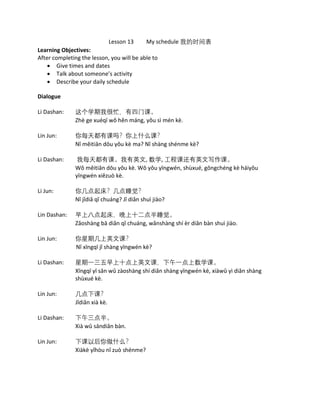
Tc1 Lesson 13 my schedule course material
- 1. Lesson 13 My schedule 我的时间表 Learning Objectives: After completing the lesson, you will be able to • Give times and dates • Talk about someone’s activity • Describe your daily schedule Dialogue Li Dashan: 这个学期我很忙,有四门课。 Zhè ge xuéqī wǒ hěn máng, yǒu sì mén kè. Lin Jun: 你每天都有课吗?你上什么课? Nǐ měitiān dōu yǒu kè ma? Nǐ shàng shénme kè? Li Dashan: 我每天都有课。我有英文, 数学, 工程课还有英文写作课。 Wǒ měitiān dōu yǒu kè. Wǒ yǒu yīngwén, shùxué, gōngchéng kè háiyǒu yīngwén xiězuò kè. Li Jun: 你几点起床?几点睡觉? Nǐ jǐdiǎ qǐ chuáng? Jǐ diǎn shuì jiào? Lin Dashan: 早上八点起床,晚上十二点半睡觉。 Zǎoshàng bā diǎn qǐ chuáng, wǎnshàng shí èr diǎn bàn shuì jiào. Lin Jun: 你星期几上英文课? Nǐ xīngqī jǐ shàng yīngwén kè? Li Dashan: 星期一三五早上十点上英文课,下午一点上数学课。 Xīngqī yī sān wǔ zàoshàng shí diǎn shàng yīngwén kè, xiàwǔ yì diǎn shàng shùxué kè. Lin Jun: 几点下课? Jǐdiǎn xià kè. Li Dashan: 下午三点半。 Xià wǔ sāndiǎn bàn. Lin Jun: 下课以后你做什么? Xiàkè yǐhòu nǐ zuò shénme?
- 2. Li Dashan: 我回家做功课。 Wǒ huíjiā zuò gōngkè. Li Jun: 你周末做什么? Nǐ zhōumò zuò shénme? Li Dashan: 我常跟家人一起去吃饭。 Wǒ cháng gēn jiārén yìqǐ qù chī fàn. Translation of the Dialogue Li Dashan: I am very busy this semester. I have four classes. Lin Jun: Do you have class every day? What classes are you taking? Li Dashan: I have class every day. There are English, Math, Engineering, and English writing. Lin Jun: What time do you get up? What time do you sleep? Li Dashan: 8 o’clock in the morning, and sleep at 12:30 in the evening. Lin Jun: What day of the weekdays is your English class? Li Dashan: Monday, Wednesday and Friday morning at 10 is English class, and 1 pm is Math class. Lin Jun: What time does your class end? Li Dashan: 3:30 pm. Lin Jun: What do you do after class? Li Dashan: I go home to do homework. Lin Jun: What do you do for weekends? Li Dashan: I go out to eat with my family often. Reading Practice 你好!我是林君。这个学期我很忙,我有五门课,还有工作。 我每天早上七点半起床, 晚上十二点半睡觉。星期一和三早上八点上英国文学课,十一点上中文课,下午四点上数 学课。星期二和四上午上英文写作课。下课以后我去书店工作。每天都很忙, 有很多功 课。晚上我在家做功课。周末我常跟家人一起去吃饭。我们喜欢吃中国菜和日本菜。 Nǐ hǎo! Wǒ shì Lín Jūn. Zhè ge xuéqī wǒ hěn máng, wǒ yǒu wǔ mén kè, háiyǒu gōngzuò. Wǒ měitiān zǎoshàng qī diǎn bàn qǐchuáng, wǎnshàng shí èr diǎn bàn shuìjiào. Xīngqī yī hé sān zǎoshàng bā diǎn shàng yīngguó wénxué kè, shí yī diǎn shàng zhōngwén kè, xiàwǔ sì diǎn shàng shùxué kè. Xīngqī èr hé sì shàngwǔ shàng yíngwén xiězuò kè. Xiàkè yǐhòu wǒ qù shūdiàn gōngzuò. Měitiān dōu hěn máng, yǒu hěn duō gōngkè. Wǎnshàng wǒ zài jiā zuò gōngkè. Zhōumò wǒ cháng gēn jiārén yìqǐ qù chī fàn. Wǒmen xǐhuān chī zhōngguó cài hé rìběn cài.
- 3. Vocabulary Simplified Character Traditional Character Pinyin English Meaning 1. 学期 學期 xuéqī N. Semester 2. 忙 忙 máng Adj. Busy 3. 门 門 men M. W. A measure for courses 4. 每天 每天 měitiān Adj. Everyday 5. 还有 還有 háiyǒu Conj. Also, in addition to, 6. 起床 起床 qǐchuáng V.O. Get up 7. 睡觉 睡覺 shuìjiào V.O. Sleep 8. 下午 下午 xiàwǔ N. afternoon 9. 晚上 晚上 wǎnshàng N. Evening 10.星期一 星期一 xīngqíyī N. Monday 11.数学 數學 shùxué N. Math 12.写作 寫作 xiězuò V.O. Writing 13.周末 周末 zhōumò N. Weekend 14.跟 跟 gēn Conj. With, and Pinyin Exercise: 1. Listen and repeat the following sound. 1. xīngqī zhōumò zhīdào 2. shùxué wénxué xǐezuò 3. qǐchuáng shuìjiào chīfàn 4. zǎoshàng zhōngwǔ wǎnshàng 5. hēchá xiàkè zuòfàn 2. Listen and repeat the following sound. 1. māng máng mǎng màng 2. shuī shuí shuǐ shuì 3. jiāo jiáo jiǎo jiào 4. xiē xié xiě xiè 5. chuāng chuáng chuǎng chuàng
- 4. 3. Repeat the following phrases. 1. Jīntiān xīngqī jǐ? 2. Nǐ xīngqī jǐ huí jiā? 3. Wǒ měitiān dōu hěn máng. 4. Gēn jiārén yìqǐ qù chī fàn. 5. Wǒ wǎnshàng zuò gōng`kè. Grammar 1. Days of the week: 星期几 (xīngqī jǐ) is to ask the day of the week. 你星期几上英文课 (Nǐ xīngqī jǐ shàng yīngwén kè,) is to ask what day of the week you attend English class. Chinese Weekdays are arranged by the number, therefore, 几 (jǐ) is a question word to ask the number of a weekday. What day of the week is today? 今天星期几? Jīntiān xīngqī jǐ? It’s Friday today. 今天星期五。 Jīntiān xīngqī wǔ. English Common way Spoken Chinese Monday 星期一 xīngqī yī 礼拜一 lǐbài yī Tuesday 星期二 Xīngqī èr 礼拜二 lǐbài èr Wednesday 星期三 Xīngqī sān 礼拜三 lǐbài sān Thursday 星期四 Xīngqī sì 礼拜四 lǐbài sì Friday 星期五 Xīngqī wǔ 礼拜五 lǐbài wǔ Saturday 星期六 Xīngqī liù 礼拜六 lǐbài liù Sunday 星期日 Xīngqī rì 星期天 Xīngqī tiān 礼拜日 lǐbài rì 礼拜天 lǐbài tiān Weekend 周末 zhōumò 2. Asking Questions with Times and Dates: 几 is used to ask about time, weekday, month, and day. Asking the time Asking the weekdays Asking the month and day 几点? jǐ diǎn 现在几点 xiànzài jǐ diǎn 你几点上课 Nǐ jǐdiǎn shàngkè? 星期几 xīngqī jǐ 今天星期几? Jīntiān xīngqī jǐ 你星期几上英文课? Nǐ xīngqī jǐ shàng yīngwén kè 几月几日 jǐ yuè jǐ rì 今天是几月几号 Jīntiān shì jǐ yuè jǐ hào 你的生日是几月几日 Nǐde shēngrì shì jǐ yuè jǐ r
- 5. 3. 还有 (háiyǒu) means “in addition”: 还有 (háiyǒu) is used to express “and”, "in addition..." or "also..." on top of the information given. For example, 我家有五个人, 爸爸,妈妈,我,还有两个弟弟。 Wǒ jāi yǒu wǔ ge rén, bàba, māma, wǒ, háiyǒu liǎng ge dìdi. 我有四门课,中文课,英文课,数学课,还有工程课。 Wǒ yǒu sì mén kè, zhōngwén kè, yīngwén kè, shùxué kè, háiyǒu gōngchéng kè. 4. Chinese sentence word order is “Subject + time + location + Verb + Object. “ Subject + Time + Location + Verb Object 我今天早上在家做功课。 Wǒ jīntiān zàoshàng zài jiā zuò gōngkè. 她星期二在书店工作。 Tā xīngqī èr zài shūdiàn gōngzuò. The time phrases can occur either before or after the subject. Time + Subject + Location + Verb Object 今天早上我在家做功课。 Jīntiān zǎoshàng wǒ zài jiā zuò gōngkè. 星期二她在书店工作。 Xīngqī èr tā zài shūdiàn gōngzuò. Word Building 忙 我很忙 你忙吗 今天我很忙 我每天都很忙 星期 星期一 今天星期几 今天星期三 你星期几工作 做 做饭 做功课 做中国菜 我会做中国菜